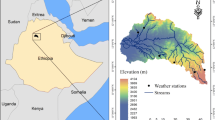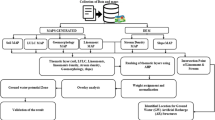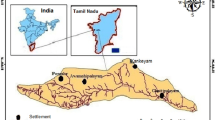Abstract
Routine application and widely accepted thought on the use of drainage density thematic layer to groundwater potential modelling (GPM) using remote sensing and geographical information system has assumed that the higher the drainage density, the lower the groundwater potential. Spatial distribution of hand pump boreholes in Dengi area points to the contrary as more than 80% of hand pump boreholes located by this study occur in areas of higher drainage density. About 23.8% of these hand pump boreholes were located less than to 50 m of the nearest stream; 19% were between 50–250 m; 42.9% were between 250–500 m; while only 14.3% were located at distances greater than 500 m from the closest stream. Spatial observation of the influence of geology, crystalline rock–sedimentary rock contact, lineament, elevation, slope, and soil on the location of groundwater abstraction structures suggest slight relationship, while the influence of lineament density is found to be minimal. The effect of streams is most consistent even as the thickness of aquifers obtained closer to streams hint at increased groundwater availability. This is in opposition to widely accepted belief. Thus, the need for a review of the traditional thought on the application of drainage density thematic layer to GPM is advocated.
Similar content being viewed by others
References
Abdullah A, Akhir JM, Abdullah I (2010) Automatic mapping of lineaments using shaded relief images derived from digital elevation model (DEMs) in the Maran - Sungi Lembing area, Malaysia. Electron J Geotech Eng 15:949–957. http://www.ejge.com/2010/Ppr10.066/Ppr10.066w.pdf
Adeyeye OA (2014) Application of remote sensing and geographical information system to groundwater studies: precedents and prospects. Unpublished Seminar paper, Dept. Of Geology, Ahmadu Bello University, Zaria, pp 6–14
Adeyeye OA (2015) Groundwater potential modeling of Dengi area, Northcentral Nigeria. Unpublished M.Sc. Research Thesis, Department of Geology, Ahmadu Bello University, Zaria, p 128
Arkoprovo B, Adarsa J, Prakash SS (2012) Delineation of groundwater potential zones using satellite remote sensing and geographic information system techniques: a case study from Ganjam District, Orissa, India. Res J Recent Sci (ISSN 2277-2502) 1(9):59–66. http://www.isca.in
Awawdeh MM, Al-Mohammed M (2009) Integrated GIS and remote sensing for mapping groundwater potential zones in Talul al Ashapif Highlands, NE Jordan. In: Conference proceedings, international symposium geotunis. http://www.slideserve.com/adele/international-symposium-geotunis-2009-16-20-december-2009
Chuma C, Hlatywayo DJ, Orimoogunje OIO, Akinyede JO (2013) Application of remote sensing and geographical information system in determining the groundwater potential in the crystalline basement of Bulawayo Metropolitan area. Adv Remote Sens, Zimbabwe. doi:10.4236/ars.2013
Directorate of Colonial Surveys, Survey Department of Nigeria (1953) Published by Northern Nigeria Survey
Egboka BCE (1988) The hydrogeological provinces of Nigeria. Water Qual Bull 13(4):117–125
Elewa HH (2011) Recent approaches in remote sensing applications for groundwater evaluation: engineering applications and water division (EAWD). National authority for remote sensing and space sciences (NARSS), pp 1–52
Elewa HH, Qaddah AA (2011) Groundwater potentiality mapping in the Sinai Peninsula, Egypt, using remote sensing and GIS-watershed-based modelling. Hydrogeol J 19:613–628
FAO (2006) World reference base for soil resources: international soil classification system for naming soils and creating legends for soil maps. World Soil Resources Report 103. Food and Agricultural Organization of the United Nations, Rome, p 126
Fashae OA, Tijani MN, Talabi AO, Adedeji OI (2014) Delineation of groundwater potential zones in the crystalline basement terrain of SW-Nigeria: an integrated GIS and remote sensing approach. Appl Water Sci 4:19–38. doi:10.1007/s13201-013-0127-9
Godebo TR (2005) Application of remote sensing and GIS for geological investigation and groundwater potential zone identification, southeastern Ethiopian Plateau, Bale Mountains and the Surrounding Areas. Unpublished M.Sc. Thesis, Addis Ababa University, p 89. http://dmzone.org/papers/RangoGodebo2005.pdf
Gupta RP (2003) Remote sensing geology. Springer, Berlin, Heidelberg, p 656
Hammouri N, El-Naqa A, Barakat M (2012) An integrated approach to groundwater exploration using remote sensing and geographic information. J Water Resour Prot 4:717–724. doi:10.4236/jwarp.2012.49081, http://www.SciRP.org/journal/jwarp (published online September 2012)
Hobma TW, Botlelier RC, Janssen LLF (1995) Groundwater modelling of a coastal dune using remote sensing and GIS. http://www.earsel.org
Jha MK, Chowdhury A, Chowdary VM, Peiffer S (2007) Groundwater management and development by integrated remote sensing and geographic information systems: prospects and constraints. Water Resour Manag 21:427–467. doi:10.1007/s11269-006-9024-4
Jones MJ (1985) The weathered zone aquifers of the basement complex areas of Africa. Q J Eng Geol 18:35–46
Lachassagne P, Wyns R, Bérard P, Bruel T, Chéry L, Coutand T, Desprats J-F, Strat PL (2001) Exploitation of high-yields in hard-rock aquifers: downscaling methodology combining GIS and multicriteria analysis to delineate field prospecting zones. Ground Water 39(4):568–581
Mayilvaganan MK, Mohana P, Naidu KB (2011) Groundwater Potential zones in Thurinjapuram watershed using geospatial techniques. Indian J Sci Technol 4(11):1470–1476. http://www.indjst.org
Mondal S (2012) Remote sensing and GIS based ground water potential mapping of Kangshabati irrigation command area, West Bengal. J Geogr Nat Disast 1:104. doi:10.4172/2167-0587.1000104
NIMET (2015) Nigeria Meteorological Agency. First quarter weather bulletin for 2015. http://www.nimet.gov.ng/quarterly-weather-bulletins
Offodile ME (1983) The occurrence and exploitation of groundwater in Nigeria Basement rocks. Niger J Geol 20(1&2):131–146
Owen R, Dahlin T (2004). Alluvial aquifers at geological boundaries: Geophysical investigations and groundwater resources, p 14. http://www.researchgate.net/profile/Torleif_Dahlin/publication/262674179_Alluvial_aquifers_at_geological_boundaries_geophysical_investigations_and_groundwater_resources/links/0deec53ad193b09102000000.pdf
PRUWASSA (2011) Drillers’ Logsfrom Kanam LGA. Plateau Rural Water Supply and Sanitation Agency, Anguldi
Sarup J, Tiwari MK, Khatediya V (2011) Delineate groundwater prospect zones and identification of artificial recharge sites Usibg Geospatial Technique. Int J Adv Technol Eng Res (IJATER) 1(1):6–20
Schoeneich K, Garba ML (2010) Hydrogeology (Geol. 405). Course Notes. Department of Geology, Ahmadu Bello University, Zaria, pp 36–37
Shahid S, Nath SK (2002) GIS integration of remote sensing and electrical sounding data for hydrogeological exploration. J Spat Hydrol 2(1):1–10
Singh AK, Prakash SR (2002) An integrated approach of remote sensing, geophysics and GIS to evaluation of groundwater potentiality of Ojhala sub-watershed, Mirjapur district, U.P., India. http://www.GISdevelopment.net
SOW-VU (1997) Compilation of a soil map for Nigeria: a nation-wide soil resource and land form inventory. Centre for World Food Studies (SOW-VU); Thirteenth West and Central African Soil Correlation Sub-Committee Meeting, Kumasi
Talabi AO, Tijani MN (2011) Integrated remote sensing and GIS approach to Ground-water potential assessment in the basement terrain of Ekiti area south-western Nigeria. RMZ Mater Geoenviron 58(3):303–328
Travaglia C, Dainelli N (2003) Groundwater search by remote sensing: a methodological approach. Environment and Natural Resource Working Paper No. 13 FAO, Rome, p 41
Author information
Authors and Affiliations
Corresponding author
Rights and permissions
About this article
Cite this article
Adeyeye, O.A., Ikpokonte, A.E. & Arabi, A.S. Geospatial signature of augmented groundwater accessibility around streams. Sustain. Water Resour. Manag. 4, 673–685 (2018). https://doi.org/10.1007/s40899-017-0153-0
Received:
Accepted:
Published:
Issue Date:
DOI: https://doi.org/10.1007/s40899-017-0153-0













